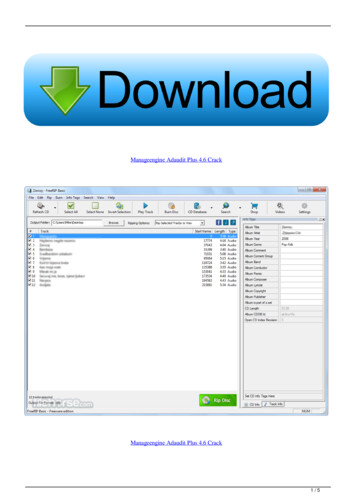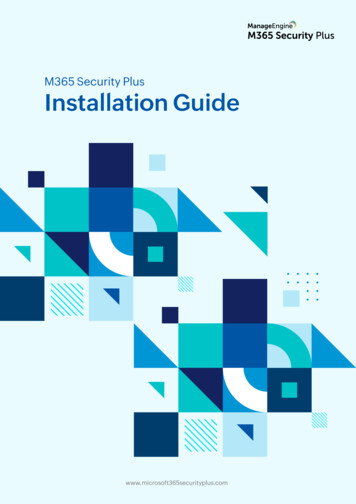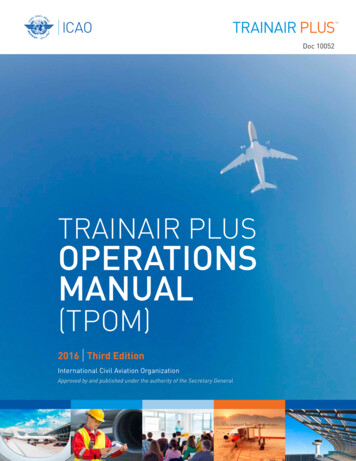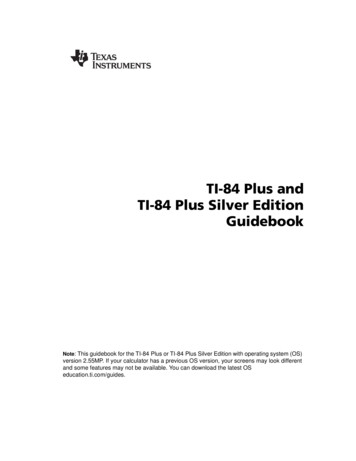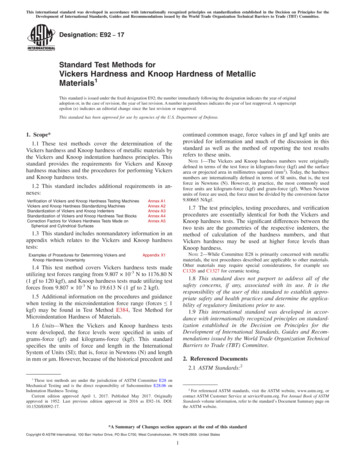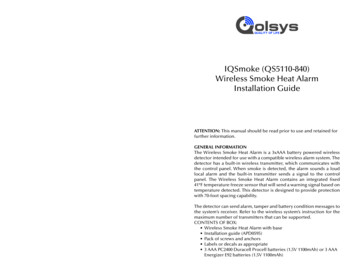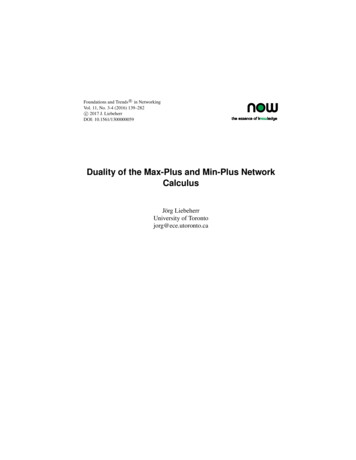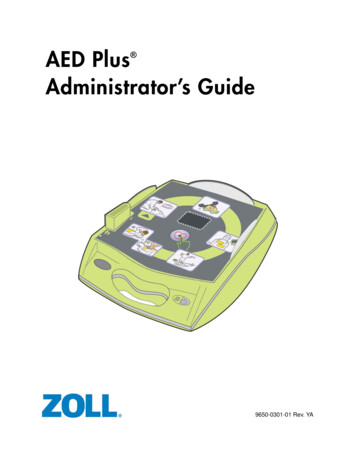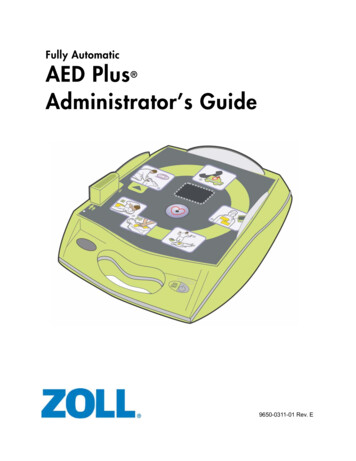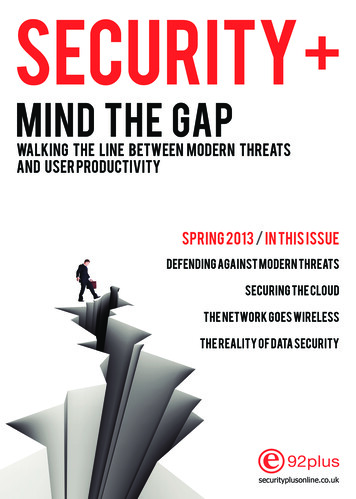
Transcription
Security The leading industry magazine from e92plusWelcome to the latest edition of SecurityPlus from e92plus:essential industry insights and interviews from your award winning distributor.It’s been an interesting start to 2013; with the challenges in the economy, the continuing growth in threats and the changingIT landscape. At e92plus, we are building on 2012’s record-breaking year and this magazine features some very excitingcontent from our vendor partners who we have started working with.In particular, this includes the leading Wi-Fi security vendor AirTight Networks, privilege management leader Viewfinity,insights on visual privacy from the world leading 3M and a Q&A from the fastest growing backup vendor in the USA, Unitrends.We also highlight some of the key vendors to visit at InfoSecurity in 2013, and we’ll be there in partnership with them. If y ouwant to arrange any demonstrations, meeting or evaluations, we’d be delighted to hear from you.Finally, we always appreciate feedback on SecurityPlus magazine – so feel free to drop us a line atsecurityplus@e92plus.com. We look forward to hearing from you.Mukesh GuptaManaging Director of e92plusInside this editionPage 3Can You See the Risk?Pages 14/15The Ponemon Institute reveal some keyfindings from a new Privacy Study.Pages 4/5BYOD: Transforming the wirelessnetworkFatpipe give some guidelines for getting yourhead in the cloud.Pages 16/17Xirrus discuss the implications of BYOD, plushow NEC visitors stay connected.Pages 6/7The All-in-One Backup SolutionThink you have covered all back-up bases?Think again. Unitrends reveal how to avoiddata loss disasters.Pages 8/9Apple vs. Android/BYOD: Balancingthe security tightropeAbsolute Software on the Apple vs Androidapp battle, plus how to manage mobiledevices in the workplace.Pages 10/11Global Data Protection Maturity in 2013Lumension assess the outlook for dataprotection within the corporate sphere.Pages 12/13The 7 Stages of Advanced ThreatsA 7 stage defence model by Websense, plusinsights from their 2013 threat report.2Top pitfalls to avoid when reaching forthe cloudEmerging trends increase the need formulti-layered endpoint securityViewfinity talk endpoint threats and why timeis money when controlling admin rightsPages 18Debunking data encryption mythsWinMagic on making encryption easy.Page 19Industry UpdateThe latest industry newsPage 20Visual data security: strengthening theweakest linkWhy your computer screen should remainunseenPage 21What and who to see at InfoSec 2012A guide to the key vendors at InfoSecPages 22/23Different Shades of Cloud Wi-Fi:Rebranded, Activated, ManagedAirtight Networks talk selection andprotection of cloud Wi-Fi.SecurityPlus magazine, exclusively from e92plus
Can you see the risk? Lostproductivity from visual privacy concernscosts 1m per yearDiversified technology company 3Mtoday announced the results of a newVisual Privacy Productivity Study,conducted by The Ponemon Institute.Key findings revealed that companiescan lose more than data as remoteworking increases, with 50% ofemployees answering that they areless productive when their visualprivacy is at risk in public places.The study showed that employees areforced to either trade-off working andrisking private data being overlookedby nosy neighbours, or stop workingaltogether. Based on these findings,lost productivity due to employeevisual privacy concerns is potentiallycosting an organisation with more than7,500 people over 1 million per year.“While many companies realise thatsnooping and visual privacy presents apotential data security issue, there hasbeen little research regarding how thelack of visual privacy impacts abusiness’ bottom line ,” says Mr.Ponemon. “As workers become moremobile and continue to work insettings where there is the potentialfor visual privacy concerns, companiesneed to find solutions to addressproductivity as it relates to computervisual privacy in addition to dealingwith the fundamental security issues ofmobile devices. ” When asked how theirconcludes by stating that equippingmobile workers with privacy filters ontheir devices makes them twice asproductive when on-screen data isprotected. With the average privacyfilter costing from 30, this can quicklybe recovered by the increase inproductivity and the potential cost ofcompromised data. Companies withmobile workers should have clear anddefined policies, educating staff ondata security and equipping them withthe appropriate tools.1. Employees are 50% lessproductive when their visualprivacy is at risk and lostproductivity costs an organisationaround 350 per person per year2. Visual privacy impacts ontransparency as users that valueprivacy are less likely to enter dataon an unprotected screen.3. Women value privacy more (61%)than men (50%), and women’sproductivity is more positivelyimpacted than men’s when thescreen is protected with a filter.4. Older employees value privacymore, with 61% of over 35’scompared to 51% of under 35’splacing importance on privacy.“Productivity loss is a major discoveryin this survey and will hopefullyorganisation handles the protection ofencourage companies across allsensitive information in a public place,sectors to consider employee working47% did not think anypractices and behaviours ,”importance was placed onsaid Rob Green, Marketingthis and that noExecutive at 3M’sadequate policiesSpeciality Display &were in place.The study showedProjection Division.“Our range ofthat employees areIn addition, moreprivacy filters andforced to eitherthan half statedscreen protectorstrade-off workingthat their visualprovide essentialand risking privateprivacy had beensecurity of onviolated whilstdata beingscreen data for atravelling or inwide range ofoverlooked by nosyother publicmobile devicesneighbours,orstopplaces such asincluding laptops,working altogether.cafes, airports andsmartphones andhotels, and two out oftablets. The newthree admitted toDetachable Privacy Filterexposing sensitive data onconcept provides the usermobile devices. The studywith the flexibility to instantly96%of data breachesthat occurred in2010 wereavoidable. 3mis the average costto business perincident of physicaldata theft.67%of workingprofessionals surveyedin the US had workedwith some type ofsensitive data outsidethe office80%Chance that you’vealready become avictim of othersreading over yourshouldertransform their tablet display from anopen to closed setting by simplyattaching the filter for instant visualprivacy. The filter can be re-attachedand detached as many times as theuser wishes, without causing anymarks or damage to the screen ordevice.”Visitors tothe 3M stand(E92) atInfosecurityEurope willsee somecreative examples of the lengthspeople go to in order to hide theirsensitive data in public spaces, andinclude devices for Apple iPhone, iPadand laptop product ranges.Can you see your risk? Request your free sample at www.securityplusonline.co.uk/3M3
BYOD : transformingthe wireless networkThe proliferation of tablets,smartphones, and other smart deviceshas increased dramatically in the pastseveral years, and use of these‘consumer class’ products onenterprise networks is nearlyubiquitous. A recent study showed90% of organisations polled allowsome level of personally ownedtechnology to be used — aphenomenon commonly referred to asBYOD (Bring Your Own Device). Manyorganizations are even contributing tothis evolution by partially fundingthe purchase of employee-owneddevices that are used as abusiness tool.Until recently, the enterprise hasbeen hesitant to embrace thetablet, having seen several falsestarts of similar products in thepast. However with tightercorporate budgets and CFOslooking to leverage the costbenefits of personally owneddevices, times have changed.Only a short time ago, standardcorporate issue was a laptop anda business-focused smartphonesuch as a Blackberry. Today, it isa laptop, full-featured smartphone,and a tablet that are coming to work— in some cases this has tripled thenumber of wireless devices accessingthe wireless network.This growth in use of smart deviceshas resulted in a dramatic shift oftraffic to and emphasis on wirelessnetworks since these devices do nothave wired Ethernet ports. This shift ischallenging IT staffs to engineerwireless networks that can support thedemands of this new paradigm todayand that are able to adapt toincreased and changing requirementstomorrow. No longer does IT have theluxury of predictability in controllingthe type and quantity of devices ontheir networks – they just need tosupport this new mobile revolution. Asa result wireless vendors are being4challenged to deliver wireless solutionsdesigned for tomorrow, not yesterday.Basic Design ConsiderationsIn granting personal mobile devicesaccess to the enterprise network,there are some basic designconsiderations which fit into twocategories: Capacity and Security.Together these address the challengesof supporting the sheer number ofdevices accessing the network andsegmenting the different classes ofusers once they are on.10.8mTB permonth6.9mTB permonth0.6mTB permonth20111.3mTB permonth20122.4mTB permonth20134.2mTB permonth201420152016CapacityCapacity deals with not just thenumber of devices, but alsounderstanding variable devicecapabilities and following bestpractices when designing the network.Some key best practices include:Maximizing the Use of 5GHzThere is up to seven times as muchbandwidth available in the 5GHz vs.2.4GHz unlicensed spectrums used byWi-Fi, as well as much less non-Wi-Fiinterference in 5GHz. As a result,optimizing use of 5GHz is afundamental requirement for achievingoptimal Wi-Fi performance. As manyWi-Fi APs (radios) as possible shouldbe set to operate in 5GHz. Typicallysome radios will need to be set to2.4GHz to support certain clients(smartphones and legacy clients). Bothspectrums must be supported in mostwireless networks, but it is key that allnew wireless infrastructure is designedwith a 5GHz focus. The latestgeneration of wireless access devicesprovide multi-state radios supportingboth bands, allowing IT managers toswitch bands as more and moredevices support the higher performing5GHz band.Design for Appropriate SignalStrengthThe Wi-Fi signal level design criteriatypically used for laptops (nominally 70dBm RSSI) is not sufficient fortablets and smartphones, especiallywhen they will be deployed in densenumbers. Since these devices transmitat lower signal levels and have inferiorantennas compared to laptops,networks must be designed withstronger signal to ensure maximumdata rates. Wi-Fi networks for tabletand smartphone support should bedesigned with a minimum -65dBmsignal strength in BOTH the 5GHz and2.4GHz bands in all locations.Provide Sufficient RadioBandwidthBecause of lower transmit power andlimited 802.11n data rate support,tablets and smartphones will typicallyachieve much lower traffic throughputperformance compared with laptops.More Wi-Fi radios are thereforerequired to support these devices in awireless environment compared to asimilar number of laptops, as multipledevices will share the same radio. Ageneral rule of thumb is to design thewireless network with enough radiosto handle the expected number ofdevices at a ratio of 15 per 5GHz radioand 8 per 2.4GHz radio for a typicaloffice or classroom levels of requiredexperience. Higher numbers of devicesper radio are appropriate indeployments without high performancerequirements, which lower limits willneed to be employed for highercapacity needs.Is your network struggling to support demand for wireless? Contact e92plus for a Xirrus demonstration
device itself may have beenrelinquished, IT must focus on thecontrol of the network and datainfrastructure in support of thesedevices. Knowing not only who is onthe network but visibility into whatdevice they are using, what applicationthey are using, and where they arelocated can feed into deciding whichaccess policies to enforce for thatuser’s session.The deployment diagram and controlchart below shows all the componentsfor an end-to-end mobility solution andhow policies can define access. Thefollowing example set of use casesdepicts how different user and devicesmay be controlled on a network.User/device management tools allowadministrators to create policies tobalance security and access in a BYODenvironment, achieving greaterproductivity without increasing risk onthe network. In the above case,corporate users with a corporatedevice can receive unrestricted access,yet that same user with a personaldevice may have restricted rights.Some devices (games) may be totallyblocked from the network. Thecapability exists today to define usersand device types – it is just a matterof defining and implementing acorporate policies.Provide Scalability/UpgradabilityAs more devices use the corporatewireless network, the network needsto be able to handle the increasedutilization of network resources. Thiscan be accomplished by deployingupgradable wireless solutions that donot require ‘forklift’ upgrades whenadditional capacity and bandwidth isneeded. New generation of wirelessproducts are engineered to providemodularity that allow the addition and/or replacements of radios withouthaving toreplace thewholeinfrastructure.UserClient DeviceAccess PolicyTheseplatformsEmployeeCorporate DeviceFull Accessoperatesimilarly to aEmployeeApproved BYOD DeviceLimited Accesstraditionalwired networkContractorApproved BYOD DeviceLimited Accesschassisallowing theGuestApproved BYOD DeviceInternet Onlyaddition ofmore radiosEmployeePersonal DeviceBlockedand the abilityto upgradeUnknownUnknownBlockedradios fromonetechnology toanother, e.g. 300Mbps 802.11n toAbout Xirrus450Mbps 802.11n to (future) 1.3GbpsOrganizations depend on high802.11ac without the concern ofbandwidth voice, video, and dataoversubscribing a centralizedgoing to and from mobile devices.controller. Today’s wireless solutionsBusiness is done in the cloud. Today,must be designed to last as long asyou need high performance wireless.wired infrastructure (5-7yrs) and thisXirrus delivers it. Our wirelessrequires a scalable/upgradable design .solutions provide wired-like capacitySecuritySecurity considerations around accesscontrol and data management arecrucial to plan. While control of theand reliability, superior security, andperform under the most demandingconditions – all in a modular,upgradable platform designed to meettomorrow’s changing requirements.The ultimate in Wi-Fi:delivering wirelessfor 3 million visitorsat the NECA major challenge faced by theexhibitions industry is persuading visitorsto take time out of the working day tovisit events. To continue attracting a highvolume of visitors, the NEC needed toenable people on site to stay connectedto their social and business circlesthrough a fast and reliable Wi-Fi network.Kathryn James, MD at the NEC, said:“NEC visitors want to stay connectedwith their social and business lives at alltimes, and our customers told us that WiFi was a priority if we wanted to makethe NEC an even better place to visit.”The NEC decided to implement Xirrus tosupport thousands of concurrent, heavybandwidth users across its exhibition,conference and organiser suites. Thenew infrastructure optimises Wi-Ficonnections for those devices operatingat 2.4 GHz range as well as theincreasing number of those using the5GHz range such as the new iPhone5.To address these issues the NEC installed155 Xirrus Wireless Arrays to provide freeand ubiquitous wireless accessthroughout the halls, offices, publicareas, catering outlets and conferencesuites, providing seamless connectivityfor up to 22,000 concurrent users.“Xirrus was the only supplier thatdemonstrated the ability to deliver highdensity Wi-Fi for the exhibition industry,”said Murray Dickson, the NEC’s BusinessSolutions Analyst. “Xirrus’ uniquegrouping of multiple APs within a singlearray was key along with visibility intoapplications on the network so we candeliver a more reliable user experience."“Having fewer physical units helped us toreduce resources spent on infrastructureinstallation, as well as support andmaintenance. Additionally, Xirrus allowsus to future proof our investment as Itsarrays are designed to support the new802.11ac standard - if we want toupgrade, we can add or swap 802.11acmodules into existing arrays,” he added.“It’s fair to say that we’re now one of themost – if not the most – diverselyconnected venues in the UK” saysAndrew McManus, IT Director at theNEC. “Our customers are now able toconnect to all of their remote services asif they are at home or in their office. Ourentire site is now hyper-connected insideand out”.Visit www.securityplusonline.co.uk/Xirrus to view the exclusive NEC Wireless Video Case Study5
The All-in-One Backup SolutionExactly what's needed fortoday's agile IT organisationsA Q&A with Unitrends’ ManagingDirector, EMEA, Kevin MoreauWith thousands of customersaround the globe you areconstantly interacting with IT staff.What do you think is IT’s biggestbackup challenge they are trying toaddress?Within the backup and data recoveryspace, there are key trends that areimpacting all IT organisations globally.Mid-market organisations (sub 1,500employees) in particular are resourceconstrained and need to manage everincreasing data growth pressures whichtax IT infrastructures and require newerand agile data recovery strategies. Askany IT Director, and they’ll tell you howvirtualisation and cloud computing havedramatically transformed the datacenter. While these technologiesprovide for many business advantages,they can also introduce unintendedcomplexities – especially for dataprotection and recovery strategies.A major question is how best to protectdata across heterogeneousenvironments. IT is now tasked in tryingto manage and protect data acrossphysical, virtualised and cloud-basedsystems and servers. Many arestruggling with this because they’veadopted a multi-vendor approach todata protection – where they areemploying different backup andrecovery vendors for different6infrastructure setups.You can’t blame them: Many traditionalbackup and data recovery solutions areineffective in virtual and cloudenvironments, and conversely, manybackup vendors today specialise only invirtual or cloud-based data protection.So, the net result is that companies aretaking on a multi-vendor approach todata protection without thinking aboutthe budgetary costs and the resourcedrain associated with doing so. Thisapproach is neither economical norpractical.The second major pain point IT is facingis how to do more with less. It’s nosurprise that the last few years have putIT departments in a tough spot –especially within the mid-market. Theyjust don’t have the budget or resourcesto deploy and manage complex dataprotection solutions. Unfortunately,many IT organisations think that thismeans they can’t receive enterpriseclass data protection – and so theysettle on mediocre solutions.What is Unitrends vision for solvingtoday’s critical backup & datarecovery issues?IT environments are complex, data isincreasing, there are fewer IT resources– our goal with every one of ourproducts is to make it easy andaffordable for our customers to protectdata across these heterogeneousenvironments. Our technology is easy touse and our pricing is simple.While many backup and recoveryvendors force companies to customizetheir data center makeup around theirdata protection solutions, we believethat companies should be able to easilyadapt their data protection solutions astheir data center evolves. As such, oursolutions not only protect data withinhybrid environments, but they alsosupport more than 100 differentversions of servers, operating systems(Windows, Hyper-V, VMware, Mac OS,Linux, AIX, Solaris), SAN, NAS,hypervisors (Hyper-V and VMware) andapplications (Exchange, SQL, Oracle). Inother words, we provide our customerswith maximum flexibility so that ITremains responsive and agile to thechanging needs of its users and to theevolving technology landscape.Additionally, as downtime tolerancediminishes, organisations are looking fora turnkey approach to data protection,overall improved performance in termsof improved backup windows, fasterrestore and recovery times; and overalllower TCO (total cost of ownership).Few backup and data recovery vendorsprovide an all-in-one solution thatenables you to protect physical andvirtual infrastructures with a single paneof glass and thus reduce themanagement overhead of managingyour complex backup environment.What is one of the most key butoverlooked aspects whenconsidering a backup solution?We’ve talked about the valueproposition of our technology – unifieddata protection that is easy to use andaffordable – and that is one of threecritical company goals that enable us tostand out in a competitive industry.However, probably the most criticalaspect does not involve the backuptechnology at all - it is your backupvendor’s customer support.With today’s complex data centers, theunfortunate reality is that it’s no longera matter of if but when a disaster willstrike. Customer support is oftenundervalued in the industry. Manycustomers put technology and priceover support, and as such, somevendors create the appearance ofcustomer service without actuallydelivering on it. Unitrends understandsthat customer support is actually asignificant business differentiator, andwe uphold a strong commitment tocustomers throughout our organisation.We want our customers to feelconfident that when the unthinkableoccurs – and their data is at risk andtheir jobs are at stake – they have astrong customer support team in placethat will guide them to a solution. Thisis the exact opposite of many othervendors in the industry that hold theircustomers’ feet to the fire when theyneed help the most. Our commitment tocustomer service and support is sostrong that we strive to achieve acustomer satisfaction rating of 98% orabove – that’s unheard of in theindustry today.Looking for more info? Access our great whitepapers & case studies online
What are theconsequencesof data loss?The consequences of data loss aredire; here is a sampling of just a fewstatistics related to the impact ofdata loss on business: 93% of companies that losttheir data centre over 10days due to disaster wentbankrupt within one year.50% of businesses that foundthemselves without datamanagement for this same timeperiod filed for bankruptcyimmediately (National Archives& Records Administration) 94% of companies sufferingfrom a catastrophic dataloss do not survive - 43%never reopen and 51% closewithin two years. (University ofTexas) 77% of those companieswho do test their tapebackups found back-upfailures (Boston ComputingNetwork, Data Loss Statistics) 7 out of 10 small firms thatexperience a major dataloss go out of businesswithin a year (DTI/PriceWaterhouse Coopers) 96% of all businessworkstations are not beingbacked up (ContingencyPlanning and Strategic ResearchCorporation) 50% of all tape backups failto restore (Gartner) 25% of all PC users sufferfrom data loss each year(Gartner)In addition, the challenge is onlygrowing– not just in the consumerspace (with 100TB uploaded toFacebook daily, or 48 hours of videoto YouTube every minute) but alsoin business with UK companiesexpecting a 42% average increasedata by the end of 2014.How confident are most ITorganisations that their backup anddata recovery strategy will hold upin the event of a disaster?When it comes to disaster recoveryplanning, many businesses start out wellenough: they conductinitial testing of theirbackup andrestorationapproach,relying on thisplan everafter.Meanwhile,thesesamebusinessescontinueto grow,and alongsidethat their data storegrows too, leaving theiroriginal disaster recovery plan outdatedand their operations at severe risk.According to Gartner, 43% of allcompanies that experience a majordisaster will go out of business if theycannot gain access to their data withintwenty-four hours. Based on NationalArchives records, 93% of businessesthat lost their data center for ten dayswent bankrupt within one year. Anyunplanned interruption in your businesscan cause loss of customers andprospects. The strategy you choose toguard against that loss depends onthese three factors:1. How much data you need toprotect2. How long you can enduredowntime of operations3. Your IT budgetThese factors will inform your decisionto adopt a virtual, cloud, or physicaldisaster recovery method, or somecombination of these, to support yourdata protection needs. Ultimately,customers want a solution that allowsthem to focus on their business ratherthan their backup.There is little difference in need fromone organisation to another; thedifference comes in terms of how theychoose to implement their strategy. Wework with companies who want an easyto-use and affordable backup and datarecovery solution that they can plug inand trust to protect rapidlyexpanding volumes ofdata acrossheterogeneousenvironments.We work withcustomers interms of whattheirenvironmentslook liketoday, whattheir evolvingvirtualisationstrategy is (ifthey have one), theamount of data theyneed to backup and protect, includinginternal SLAs they may have aroundRTO and RPO – essentially we do anentire tech audit. We also walk themthrough optimal data recovery strategies- ensuring that they have a plan, theytest it, and re-test it.Additionally, we’ve found that resellersare looking for better ways to addressthe needs of their existing customers,and also to attract new customers. Theyare looking for a truly adaptive andscalable solution, offering completeprotection - physical, virtual, and cloudenabled - for their customers. We offerresellers a proven back up and datarecovery all-in-one solution that’sappealing to their customers.Can you talk about the competitivelandscape and why Unitrendsoffering will win over competingproducts/services?Are there certain industries that aremore versed in best practicesregarding data recovery strategies?Let me reiterate that our business model– focused on unified and affordable dataprotection, coupled with unrivaledcustomer service and support. No otherprovider offers all-in-one data backup,archiving, instant recovery and disasterrecovery solutions capable of addressingthe needs of businesses as they moveinto the cloud, embrace virtualisationand maintain existing physicalinfrastructure.We serve companies of all sizes andacross all verticals both in the U.S. andinternationally. They come from a rangeof industries – government, education,healthcare, energy, transportation,financial services, and more. Regardlessof the industry, data is the lifeblood ofyour organisation and something thatneeds to be protected at all costs.Plus, our unparalleled ability to addressbusinesses’ data protection needsregardless of which IT assets they havein place is backed by an equally robustcustomer support. We offer the midmarket enterprise-class data protectionat the lowest TCO in the industry. That’sa winning combination that no otherbackup or data recovery vendor can top.Request your free evaluation licence for Unitrends Backup Service at www.securityplusonline.co.uk/Unitrends7
Apple vs. AndroidWar Extends into Enterprise AppDevelopmentAbsolute Software research showsApple only just dominates inenterprise app development in UKand US, while Android wins inEurope.Independent research released byAbsolute Software shows that Appleonly just wins out when it comes toenterprise app development. Although,Android trumps the technology giant inboth France and Germany.The global survey of CIOs,commissioned by Absolute Software,the industry standard for persistentendpoint security and managementsolutions, shows that nearly two thirds(64%) of UK companies chose Appleas their default operating system forapp development. Compare this to lessthan half (41%) of French companiesand 53% of Germany companies.“In order to win the app battle,Android needs to bump up theirsecurity to the standard set by Apple.As different devices make their wayinto the enterprise, employees expectgreater access to business applicationsand data from the field. This presentsan increasingly difficult challenge forIT who need to manage and support adeployment across a multitude ofoperating systems and form factors ,”remarked John Sarantakes, Senior VicePresident and General Manager, EMEAfor Absolute Software.The fact that Samsung Galaxy iscontinuing to beat the iPhone 5 in thesmartphone war could be a reflectionof France and Germany being moreopen to BYOD practice. The sameresearch found that the UK sees theintegration of business and personaldata as far less important thanGermany or France. Fewer than fourout of ten (39%) CIOs in the UK see itas the future, compared to 59% inFrance and 50% in Germany.“IT needs to recognise this shift andbe prepared to address security orproductivity fears that may arise, asthe battle of platforms is not going toend any time soon , ” commented Mr.Sarantakes.In the security battle,Apple is KingFor the most part, the most requestedapp for employees is email. However itappears that IT is most fearful of filesharing apps and, only 9% of ITdecision makers would choose to buildan app for email. These figures reflectthe fear of Android security vs. theseemingly ‘ironclad’ iOS platform.When it comes to blacklisting apps, UKorganisations are the most concernedabout security in relation toblacklisting, with 93% stating securityconcerns over productivity reasons.The keen focus on security in the UK isa possible reason for Android laggingbehind in terms of enterprise appdevelopment.One area where organisations canretain control over data is through selfpublished apps, rather than relying ongeneric third party apps. This caneither be bespoke developments, orthrough solutions such asAbsoluteApps to distribute in-houseapps, or AbsoluteSafe which allows forfully secure distribution of confidentialfiles and data.8When it comes to influencing BYODpolicies, ther
the security tightrope Absolute Software on the Apple vs Android app battle, plus how to manage mobile devices in the workplace. Pages 10/11 Global Data Protection Maturity in 2013 Lumension assess the outlook for data protection within the corporate sphere. Pages 12/13 The 7 Stages of Advanced Threats A 7 stage defence model by Websense, plus
